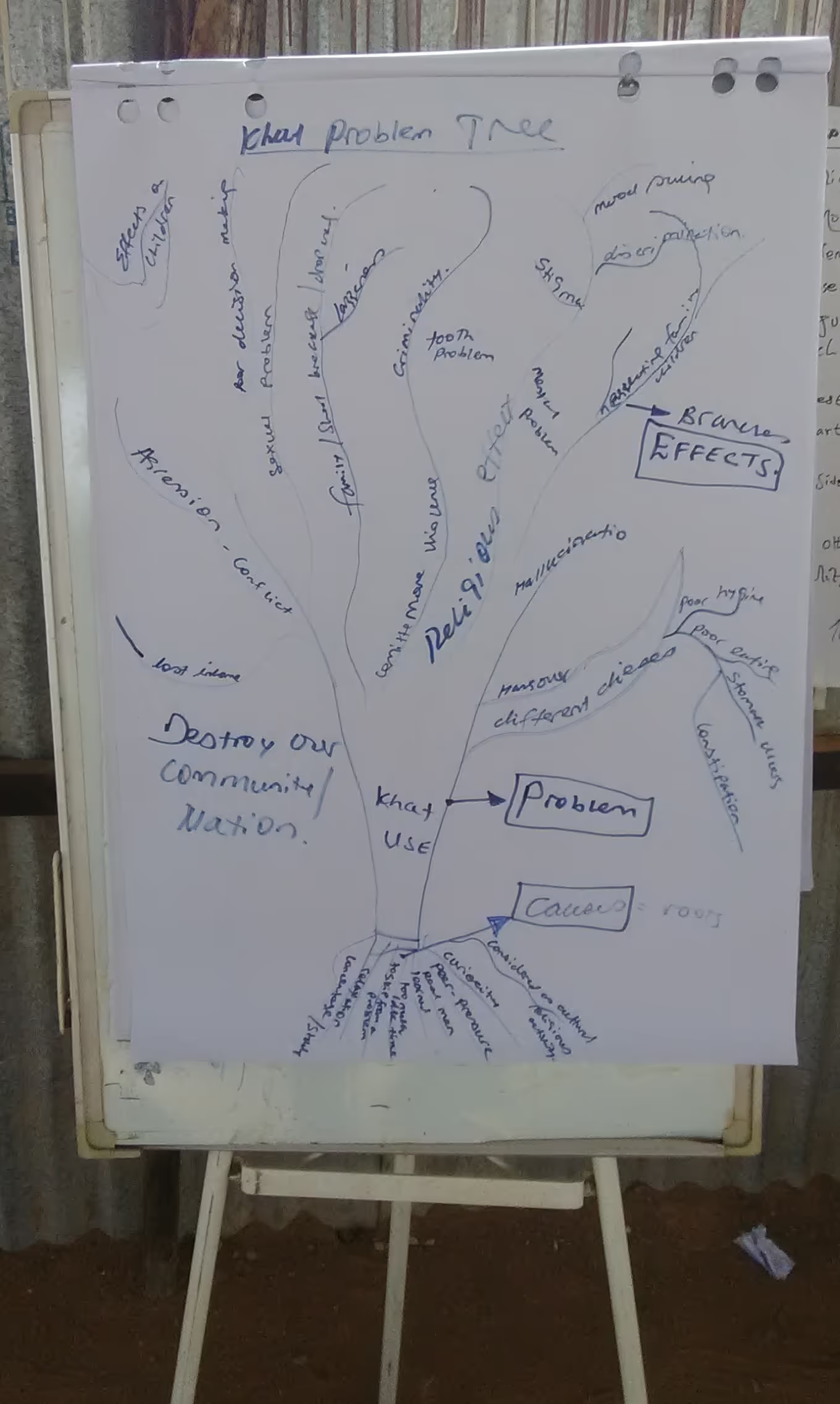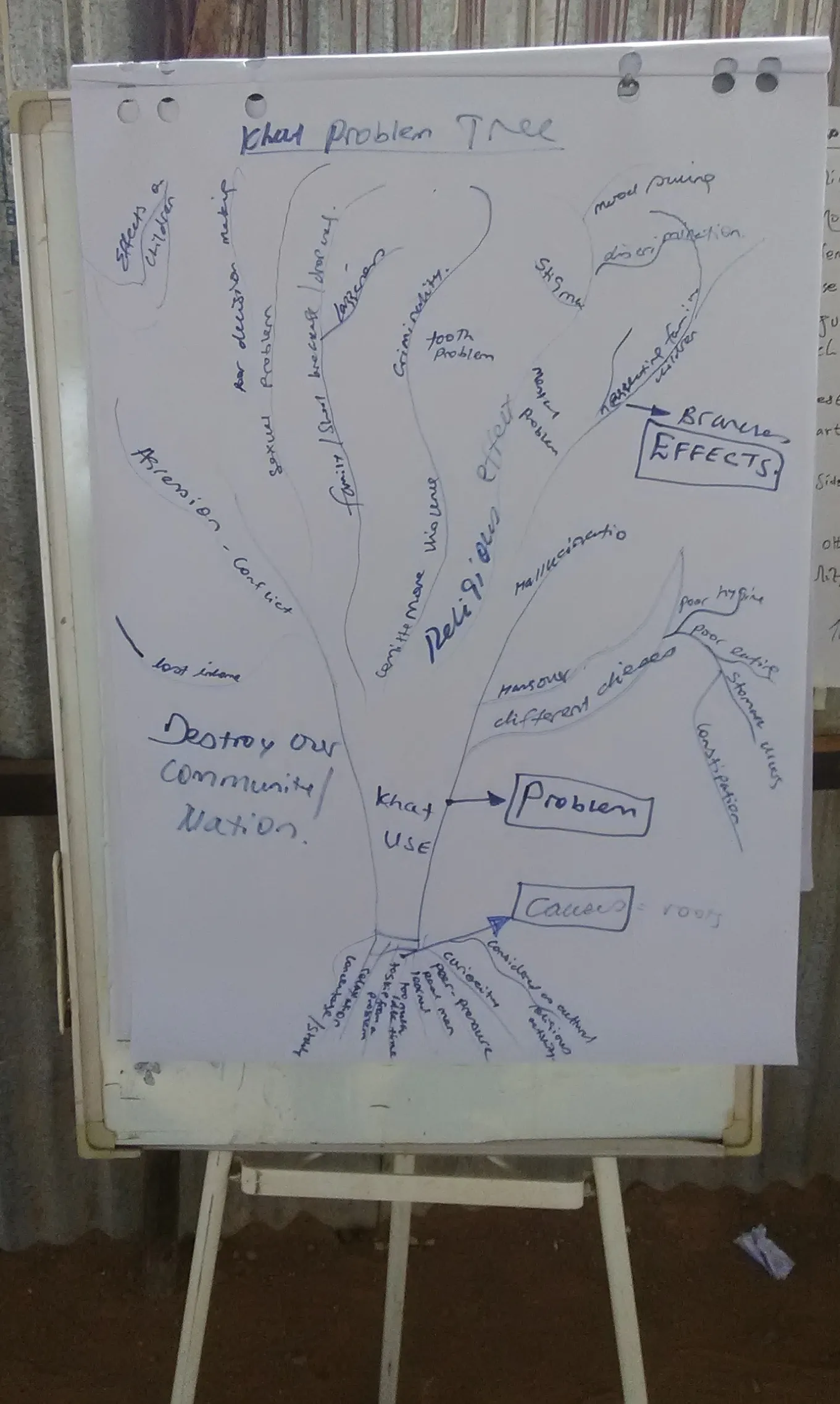A plant sold respectfully, yet damages homes

It was a regular working day, a Monday morning, in the center of Bokolmayo refugee camp when I heard the sudden chanting and loud horn of a three-wheel vehicle, the locals call it a Bajaj. At first I thought someone was getting married - in my country people usually use the horn of a vehicle to show their excitement and happiness during weddings. But later I was told that the horn, the chanting and the noise was a wake-up call to khat chewers, informing them that the long awaited khat had arrived at last. I previously wrote a blog post about khat that you may find here.
Although I was aware that many people chew khat, I had never seen such excitement in my entire life. In a matter of minutes, the whole vehicle was unloaded while customers were surrounding the vehicle and waiting for the start of business. Lots of questions were jumping around in my head (e.g. What? Why?). Then I saw a young lady running to the other corner and unloading khat from the Bajaj. I followed her to her shop and asked if I could talk to her about khat, how much it costs, etc., and she agreed to talk to me.
She allowed me to take a picture of her khat and told me the prices. The entire sack of khat, weighing around 30-40 kg costs 3520 birr (~$128 USD). Within this sack there are around 6 bunches and each bunch costs around 340 birr (~$12 USD). Most of the time this price is too expensive for one individual to buy the entire bunch rather two people will buy one bunch and share it. However, there are some who spend 340 birr and keep on coming until they are told there is no khat.
This khat merchant, she makes her living by selling khat, indicated that she is not happy about her business. I asked her why not and she said “… I consider the leaf I sell to be a source of conflict, violence and much illness to most of the family members of my customers. Although I don’t like what I am doing, I have to participate in this business so as to buy daily bread for my kids and cover other expenses.”
She explained that she has some customers who buy the whole bunch, spending more than 340 birr at a time, and keep on coming back for more once they are at the highest peak of stimulation. “I tell them to go away or say '…didn’t you consume enough, why don’t you go home and rest?' but they still insist on more. Although I may be angry about the amount of money they spend, I also have to look out for my business. Ultimately, I sell to them feeling pity for their spouses. I sometimes ask myself what sort of potential violence I am creating among couples by selling this drug, but give up my thinking as I still have to cover my own expenses."
The quantity of khat delivered by the Bajaj is not enough for the demand, and she states “… I often wonder what I can do to convince my customers to chew less, and this would then lead to fewer problems for them and their families, yet at the same time without significantly affecting my income,” she told me. "If there were other work opportunities in the camp, I would have given up this business, but there are none in this setting," she explained. She continued, “… I know so many of my customers whose relationships are unhealthy, who have completely neglected their family and who are happily married to khat,” adding that she is scared to be judged by Allah for selling a drug.

In the end, I told this brave young lady about the curriculum session we have developed on khat use and its consequences. I shared with her that if people realize the negative consequences of khat, they might reduce consumption which might affect her business. At first I thought she might be opposed to such an intervention. But to the contrary, this lady appreciated what we are doing and even asked if she can join the discussion to learn more about the cost of khat to families and perhaps insist on selling less to regular, high-quantity consumers.
After pretesting the intervention session on khat that we developed for this setting, I learned that khat use has so many negative consequences, contributing to unhealthy relationships between users and their family members. Individuals like this khat merchant and other people we approached in fact know that khat is a drug and is not a nice thing but did not see the cause and its effects in a systemic and organised manner. We need to continue to promote awareness of the negative consequences of khat!
I also noticed that if there were more job opportunities, khat merchants may seek other work, which may reduce the supply of khat. Similarly, one of the root causes of khat use is absence of employment opportunities for consumers as well. Thus in addition to our intervention, we see the importance and value of increasing employment opportunities in order to reduce the harm khat does to people within intimate relationships.
By Samuel Tewolde
Intervention Specialist for Emergency Operations
WAHA International-Ethiopia
Stay updated
Sign up for our newsletter to receive regular updates on resources, news, and insights like this. Don’t miss out on important information that can help you stay informed and engaged.
Related articles
.png)


Explore Elrha
Learn more about our mission, the organisations we support, and the resources we provide to drive research and innovation in humanitarian response.